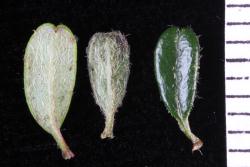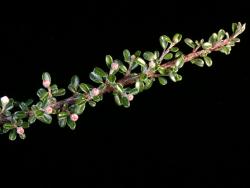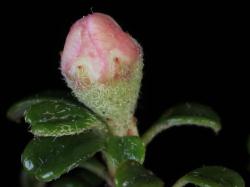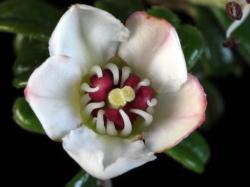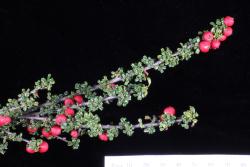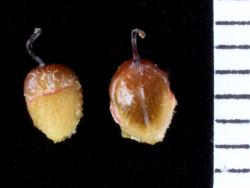- ≡ Cotoneaster microphyllus var. thymifolius (Baker) Koehne, Deut. Dendrol. 227 (1893)
Prostrate shrub, evergreen. Branches trailing and with ultimate branchlets at a very narrow angle to the main stem, sometimes dense and regular; branchlets grey-brown with peeling cuticle, branchlet hairs sparse, white; stipule 0.8 mm long, green to pink, sparse, white. Leaves crowded, sometimes sparse on long branchlets on branches, 6.0–6.8 mm long, lamina 4.5–5.6 mm long, 2.3–2.9 mm wide, obovate, distinctly V-shaped, c. 300 µm thick, petiole 0.7–1.8 mm long, glabrous; leaf base cuneate; leaf apex obtuse, emarginate, apiculus downwards; lateral veins not visible, midvein only impressed above and projecting below; upper surface smooth, moderate yellowish-green (RHS 137C), glossy, upper surface hairs none; margins slightly recurved, hairs none; lower surface glaucous, hairs sparse, white, thick (strigose) or none.
Flowers solitary on branch 6–8 mm long with 2–4 leaves, pedicel 1.0–2.0 mm long, hairs dense, white. Flowers 3.4–4.0 mm in diameter. Hypanthium green, sepals 0.7 mm long, 1.2 mm wide, hairs moderately dense, white, straight (strigose). Petals pink in bud, when open spreading, white with pink on outside at apex, 2.0 mm long, 2.3 mm wide, not clawed, glabrous, margins entire, minutely papillose. Stamens 16; filaments 1.8 mm long, white; anthers dark red-purple, 0.7–0.8 mm long; styles 2, 1.6 mm long. Fruit strong red (RHS 46A), oblate-obovate, 5.2–6.5 mm long, 6.1–7.5 mm diameter, calyx somewhat open, hairs a few at apex and base. Pyrenes invariably 2, 2.8–3.2 mm long, 2.3–2.4 mm wide, hairs sparse on outer face or only at apex, apex rounded with style attached at pyrene apex.
By the low, prostrate form with long leading branches and short side-branches, tiny obovate leaves that are glossy on the upper surface with the midvein in a groove but the lateral veins not visible, the lower surface glaucous with sparse strigose hairs, the leaf apex recurved so as to appear emarginate, the small solitary flowers that are pink in bud, but white when open and spreading, the pink-red oblate fruit.
Most similar to Cotoneaster microphyllus but has smaller leaves (4.5–5.6 mm long × 2.3–2.9 mm wide, not 5.3–10.0 mm long × 3.3–6.0 mm wide).
Known from Southern North Island (Raumati South, 2012), Canterbury (Christchurch Botanic Gardens, 1962–2016, Christchurch City, 1987)
Flowering: October; Fruiting: February to May
Diploid (Fryer & Hylmö 2009), confirmed by flow cytometry using CHR 638081.



